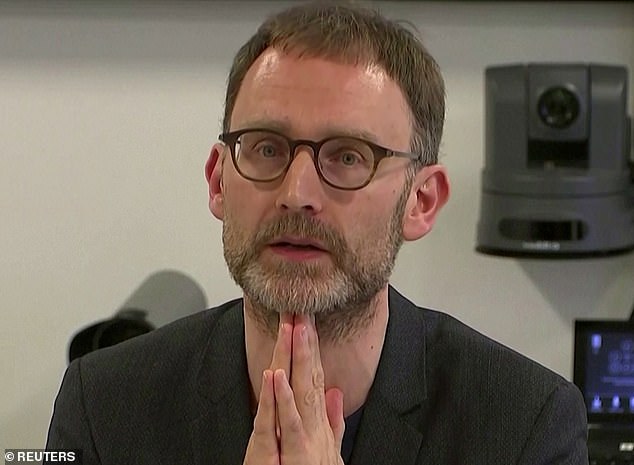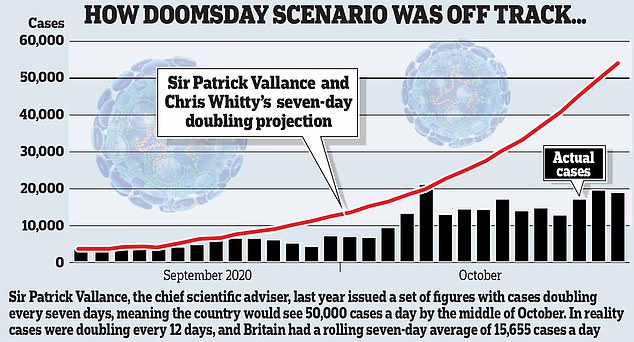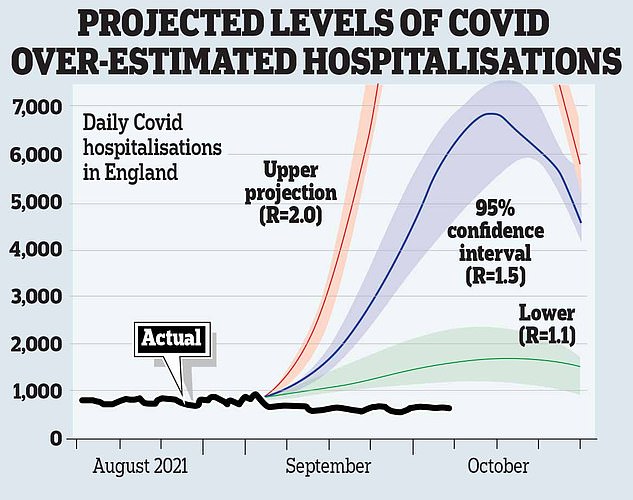Boris Johnson’s opponents want the world to believe that thousands of Britons died because a cavalier Prime Minister and his cruel, callous colleagues in the Tory Party rode roughshod over scientific advice.
That’s why the Government’s opponents lost no time yesterday morning in trying to exploit the dramatic new report into the Covid-19 pandemic in Britain to reinforce their preferred narrative.
Shadow health secretary Jonathan Ashworth said the ‘damning report’ revealed ‘monumental errors made by ministers in responding to the pandemic’.
He added: ‘Ministers were warned but responded with complacency.’
What Mr Ashworth and others failed to point out in their rush to put out statements is that the two committees who wrote the report were actually making the opposite point: that the scientific advice itself was wrong and that Mr Johnson and his Cabinet colleagues followed it slavishly.
If ministers did make an error it was not in closing their ears to scientists’ pleas – it was in failing to interrogate them properly.

Predictions: Professor Neil Ferguson (pictured above), who published a paper predicting up to 500,000 deaths from Covid if the Government did nothing to tackle it
The report could not be clearer on this. It asserts that other countries made better decisions specifically because their leaders used their own judgment rather than relying so exclusively on scientific advisers.
Other governments, the report claims, had ‘greater licence to take decisions more quickly’. Nor were they hamstrung by pandemic plans that proved hopelessly inadequate because they were based on a flu epidemic, not a novel coronavirus.
Britain is a global scientific leader, boasting more Nobel prizes than any country bar the United States. Our universities frequently top international league tables for the quality of scientific teaching and research.
And many British scientists conducted themselves admirably during the pandemic: not least those who designed the AstraZeneca vaccine (sold at cost) and who developed some of the first Covid tests.
No, it is one very particular group of scientists who have, as we all know by now, dominated Britain’s response to Covid: the 92 members of the Government’s Scientific Advisory Group for Emergencies – or Sage, to use its thoroughly inappropriate acronym.
Until last March, few Britons were even aware of the existence of the group, still less which luminaries were on it. At the beginning of the pandemic, its membership was a closely guarded secret. Now the names of its most prominent members trip from the tongue like so many celebrities’.
Led by the Government’s chief scientific adviser Sir Patrick Vallance, Sage also includes such notorious figures as Imperial College’s ‘Professor Lockdown’ Neil Ferguson, who last May resigned in disgrace after it was revealed that he had broken the lockdown rules he had drawn up to restrict everyone else’s lives – by allowing his married mistress to visit his flat.
He has since quietly crept back on to the group and is still given a platform on the BBC. Other regulars on Auntie’s broadcasts are professors Graham Medley and John Edmunds, who are on record in March 2020 as having advocated a herd immunity approach. They later performed a dramatic U-turn, demanding we stay under severe restrictions even when Covid infection numbers were low.

Led by the Government’s chief scientific adviser Sir Patrick Vallance (above), Sage also includes such notorious figures as Imperial College’s ‘Professor Lockdown’ Neil Ferguson
On Sage, too, is deputy chief medical officer Jenny Harries, who in March 2020 confidently assured us all that masks could actually ‘trap the virus’ and make its spread more likely. That was somewhat at odds with the advice given by another familiar Sage member, long-standing Communist Party member Susan Michie, in a television interview this June, who laughed merrily as she said we would have to go on wearing masks ‘forever’ – in spite of most of the population by then having been vaccinated.
It is nice to know there is some vigorous debate among Sage members, but it isn’t very helpful for us, the public, to be given such contradictory advice from a body that is supposed to be charged with producing a scientific consensus on how to tackle an emergency.
Only the most tribal voters would not feel a degree of sympathy for ministers who had to make hugely important decisions on the back of advice and predictions that turned out to be so wide of the mark – even if the same scientists also gave a stamp of authority to Government decisions.
Sage has been getting things wrong on Covid right from the beginning. Some of the earliest Covid tests were developed in Britain in January 2020, the same month as the disease was first reported by the World Health Organisation (WHO), having been circulating in China for some weeks previously.
Yet, as we learn from the MPs’ report, Sage failed to develop a testing system to learn how the disease was spreading, telling the committee on January 28 that testing asymptomatic people would ‘not be useful’. Yet at the same meeting Sage members told MPs that they suspected asymptomatic transmission was occurring. Had we started testing people then, we would have had six weeks to prepare for the explosion of cases that occurred in March.
As late as March 12, Sage members were still advocating a policy of herd immunity. On that day, Sir Patrick told reporters at the first of what became daily press conferences in Downing Street: ‘It’s not possible to stop everybody getting it and it’s also actually not desirable because you want some immunity in the population. We need immunity to protect ourselves from this in the future.’
Four days later Sir Patrick and many in Sage did a screeching handbrake turn after a paper was published by Prof Ferguson predicting up to 500,000 deaths from Covid if the Government did nothing to tackle it.
Within a week, the country was in full lockdown, with police apprehending sunbathers in London parks and deploying drones to catch those who dared go for a harmless walk in the Peak District.
Yet Prof Ferguson’s study was every bit as dubious as Sage’s previous advice. We will never know what would have happened had the UK Government done nothing to tackle Covid-19, but we can get some idea of the usefulness and quality of the professor’s modelling thanks to a team at Uppsala University in Sweden.
In April 2020, these researchers used a version of Ferguson’s model



to predict that Sweden would suffer 90,000 deaths by the end of May 2020 if it carried on with its liberal policy, and 40,000 deaths if it introduced a full lockdown. In the event, Sweden didn’t impose a lockdown – and suffered just 4,350 deaths by that date.
Following criticism that the UK Government didn’t impose its first lockdown early enough, Sage seemed to flip to the opposite extreme.
In September 2020, for example, it implored the Government to introduce a two-week ‘circuit-breaker’ lockdown to forestall a second wave of Covid. The Welsh government later took the advice – only to find infection numbers surging again when the two weeks were up.
When the Government at Westminster refused at first to call a second lockdown, Sage’s sub-committee on modelling, SPI-M, produced a frightening-looking graph showing deaths peaking at 4,000 a day by the middle of December – a graph which did nudge the Prime Minister into calling that second lockdown. Yet as others pointed out, the graph was already out of date when it was published.
Sage has continued getting it wrong ever since, most recently on September 8 when it predicted 6,000 hospitalisations per day by early October as schools and colleges returned. Fortunately, the Government resisted calls for school closures or another lockdown – because the number of people being admitted to hospital has fallen since then, from around 1,000 per day to 800 or so.
‘Follow the science,’ we were told ad nauseum at the start of the pandemic. As today’s report makes clear, that’s exactly what the Government did in the first three months of the crisis – by bowing to Sage’s every recommendation.
And a fat lot of good it did. Scientific method might often give us answers to life’s problems, but in the case of Sage’s modelling the Government might as well have responded to Covid by reading tea leaves.
Source link : https://www.dailymail.co.uk/debate/article-10085607/Demands-herd-immunity-prediction-500-000-Covid-deaths-call-Sage.html











